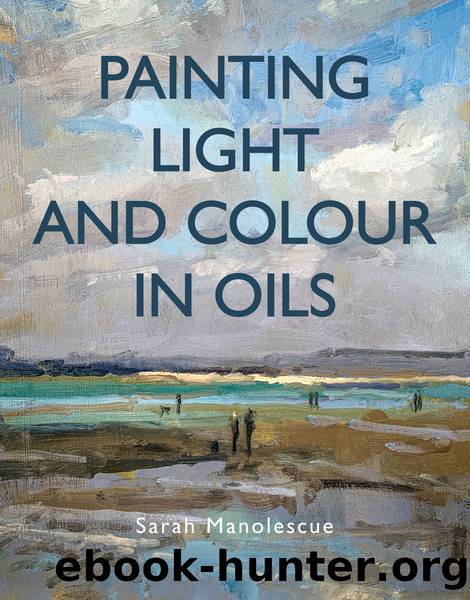Painting Light and Colour in Oils by Manolescue Sarah;

Author:Manolescue, Sarah;
Language: eng
Format: epub
Publisher: The Crowood Press
Last Light, Bramshott, oil on panel, 9in à 10in (23cm à 25cm). Keen observation and accurate colour mixing can result in a believable capture, even with the loosest of brushwork. Some Indian yellow made it on to my palette for this, which proved invaluable.
Tillington Sheep, Sundown, oil on panel, 9in à 11in (23cm à 28cm). The quality of light can influence the strength of colour and tone, as seen here. A haze affects the scene as a whole and results in lost edges.
Letâs take two paintings (Tillington Sheep, Sundown and Last Light, Bramshott) and draw some comparisons. On the face of it, both are quite similar compositionally and both were painted on a cold winter afternoon. At first glance you could say the colours used are similar (purples, blues, corals, plums, yellows â¦), but if we look closer, are they really? The clarity of light when I painted in Bramshott was greater, so therefore the colours are sharper, stronger and richer. The sky colours are totally different between the two paintings. Even the yellow of the sun differs between them (there was a haze when I painted at Tillington). I do think that premixing here would have brought out the lazybones in me and I would have used the colour with a âclose enoughâ attitude. But thatâs not what weâre striving for â colour accuracy can elevate a painting and it is a crucial discipline for the plein air painter to master. Painting a sunset heavily relies on capturing the atmosphere, and with acute observation this is possible.
The Stages of Dusk
Itâs helpful to think about the stages of dusk or dawn before painting. I often will paint two or even three paintings during the magic hour (or so), and each one will be different to the last. I tend to start with larger boards and, as I get tired, move to something smaller that I can cover more quickly. First, letâs consider the stages of dusk.
Stage 1
The sun is beginning its descent but is still sitting a way above the horizon line. Any surrounding clouds are beginning to develop more colour and warmth. A lower sun throws longer shadows on the landscape, but the effect in terms of colour is minimal â we can still see greens. The sun is a bright white/yellow. Sundown Haze (at the beginning of this chapter) perfectly illustrates Stage 1 of dusk. Painted on a cold winter afternoon, the warmth of the evening light was beginning to develop â see the subtle pinks of the upper cloud wisps. The haze served to diffuse the light, so the shape of the sun is distorted. The sun was catching on the distant estuaries, but the immediate foreground is unaffected by the sun at this stage, and much of the landscape is still visibly âdaytimeâ green.
Stage 2
The sun is sitting close to the horizon and colour temperatures are at their warmest of the three stages, the sun turning from a bright white to something richer (in some cases red).
Download
This site does not store any files on its server. We only index and link to content provided by other sites. Please contact the content providers to delete copyright contents if any and email us, we'll remove relevant links or contents immediately.
| Landscape | Oil Painting |
| Portraits | Still Life |
| Watercolor | Acrylics |
Learn Drawing Quickly by Sharon Finmark(2095)
The Husband's Secret by Liane Moriarty(2047)
Drawing and Painting Birds by Tim Wootton(2005)
The Unlikely Pilgrimage of Harold Fry by Rachel Joyce(1838)
Classical Drawing Atelier by Juliette Aristides(1776)
One Drawing A Day by Veronica Lawlor(1497)
The Art of Creative Watercolor by Danielle Donaldson(1455)
Oil Painting For Dummies by Anita Marie Giddings & Sherry Stone Clifton(1408)
Anywhere, Anytime Art: Crayon by Monika Forsberg(1317)
Hieronymus Bosch by Virginia Pitts Rembert(1311)
Special Subjects: Basic Color Theory by Patti Mollica(1295)
Post-Impressionism by Nathalia Brodskaya(1289)
Woman's Mysteries by Esther Harding(1247)
Elizabeth Is Missing by Emma Healey(1234)
Memory's Wake by Fenech Selina(1189)
Fundamentals of Drawing by Barrington Barber(1059)
Acrylic Fusion by Dan Tranberg(1028)
Landscape Painting in Pastel by Elizabeth Mowry(1024)
Drawing by William Powell(1002)
